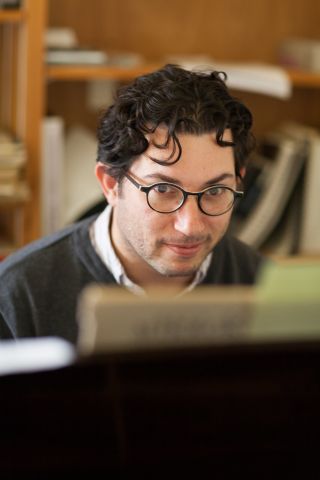Matan Rubinstein – Music on Teaching at Marlboro

During my first visit to campus, I was immediately struck by the refreshingly direct and honest communication between members of the Marlboro community, and the enthusiasm and intellectual activism exhibited by the students I met. There was a great atmosphere of curiosity coupled with a certain casual air about interactions I related to very naturally. I have found most of my work days at Marlboro joyous and productive, and I like my students very much.
ON ACADEMICS AT MARLBORO
My students run the gamut from the focused to the freewheeling, but are generally intelligent and likable. Marlboro’s strength is the infinite freedom for self-motivated students to explore, and the great flexibility and streamlining of procedures for setting up courses and tutorials so students can benefit from a “customized” course of study.

ON TEACHING MUSIC
Teaching music is the best way I know of to prove the infinite ways in which people conceive of and hear music. Every time I teach a piece of music, someone brings a distinctly different way of hearing it. I usually get most satisfaction teaching the two edges of the discipline: the highly specialized interests which often inform my own work as a musician, and the very basic notions informing the making and thinking of music, regardless of idiom. Teaching forces me to delve deeply into other musicians’ work in a way I might be reluctant to do otherwise. In my attempt to explain an aspect of some musical work, I often find I get a fresh insight into mine.
ON HIS OWN MUSICAL DEVELOPMENT
As I was growing up, the contemporary music scene was bubbling with eclecticism, and I soaked it all up. I find it liberating to have grown up in a music-cultural environment where there really was no real rift between highbrow and lowbrow, composition and improvisation, acoustic and electronic music. Now, though, I am interested in making sense of the connections between all these disparate elements rather than basking in the sheer differences between them. As I grow older, I feel increasingly compelled to find a “unified musical field” of sorts.

ON RECENT COMPOSITIONS
I was commissioned to make two electronic music pieces by choreographer Peggy Choy, to be used in a dance. The subject of the pieces is the haenyeo, or diving women of Jeju Island, near South Korea. The haenyeo dive for mollusks without SCUBA gear, and can spend a few minutes under water, swimming with this incredibly spare, economical grace. Peggy got me started, specifying the use of audio materials taken from various documentary recordings: a woman talking about her life as a diving woman, a rowing song sung by the women when they head out to the sea in their boats, and more. She performed her choreography to the first piece in Los Angeles this fall, and is scheduled to dance to both pieces in Berlin in November 2011.

